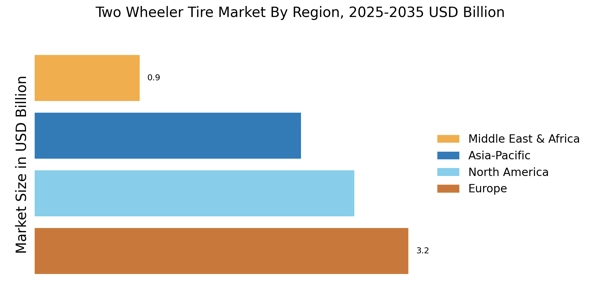Urbanization and Increased Commuting
Urbanization continues to drive the Two Wheeler Tire Market as more individuals seek efficient commuting solutions. With urban populations expanding, the demand for two wheelers as a practical mode of transportation is on the rise. In 2025, it is estimated that urban areas will witness a 15% increase in two wheeler registrations, leading to a corresponding demand for tires. This trend is particularly pronounced in densely populated cities where traffic congestion and limited parking space make two wheelers an attractive option. As a result, tire manufacturers are likely to focus on producing tires that offer superior performance and longevity, catering to the needs of urban commuters and thus enhancing the Two Wheeler Tire Market.
Government Initiatives and Regulations
Government initiatives aimed at promoting sustainable transportation are playing a crucial role in shaping the Two Wheeler Tire Market. Policies that encourage the use of two wheelers, particularly electric models, are being implemented in various regions. For instance, incentives for electric vehicle purchases and stricter emissions regulations are likely to boost the demand for eco-friendly tires. In 2025, it is expected that such regulations will lead to a 25% increase in the market for tires designed for electric two wheelers. This regulatory environment compels manufacturers to adapt their product offerings, thereby driving innovation and growth within the Two Wheeler Tire Market.
Growing Interest in Recreational Riding
The rising popularity of recreational riding is emerging as a significant driver for the Two Wheeler Tire Market. As more individuals engage in leisure activities such as off-road biking and touring, the demand for specialized tires designed for these purposes is increasing. In 2025, the recreational segment is projected to grow by approximately 18%, reflecting a shift in consumer preferences towards adventure and outdoor activities. This trend encourages tire manufacturers to develop products that enhance performance in diverse terrains, thereby expanding their market reach. Consequently, the Two Wheeler Tire Market is likely to benefit from this growing interest in recreational riding, as it opens new avenues for innovation and product differentiation.
Rising Demand for Electric Two Wheelers
The increasing adoption of electric two wheelers is a pivotal driver for the Two Wheeler Tire Market. As consumers become more environmentally conscious, the shift towards electric vehicles is evident. In 2025, the electric two wheeler segment is projected to account for a substantial share of the overall two wheeler market, with estimates suggesting a growth rate of over 20% annually. This surge necessitates the development of specialized tires that cater to the unique requirements of electric models, such as enhanced durability and lower rolling resistance. Consequently, manufacturers are focusing on innovation in tire design and materials to meet this demand, thereby propelling the Two Wheeler Tire Market forward.
Technological Innovations in Tire Manufacturing
Technological advancements in tire manufacturing are significantly influencing the Two Wheeler Tire Market. Innovations such as smart tires equipped with sensors for monitoring pressure and temperature are becoming increasingly prevalent. These technologies not only enhance safety but also improve fuel efficiency and performance. In 2025, it is anticipated that the integration of smart technology in tires will lead to a 10% increase in market demand. Furthermore, advancements in materials science are enabling the production of lighter and more durable tires, which are essential for high-performance two wheelers. As manufacturers invest in research and development, the Two Wheeler Tire Market is poised for substantial growth driven by these technological innovations.


















Leave a Comment